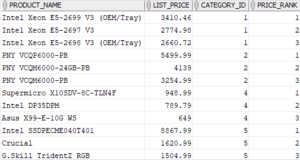REQUEST COMPLIMENTARY SQLS*PLUS LICENCE
Oracle RANK function

Oracle/PLSQL RANK function returns the value rank in the value group. It is very similar to the DENSE_RANK function. However, the RANK function may not return a consecutive ranking if the values under test are the same. Whereas, DENSE_RANK will always result in a consecutive ranking.
The RANK function can be used in two ways – as an aggregate function or as an analytical function.
Syntax #1 RANK function – used as an aggregate function
As an aggregate function, the RANK function returns the rank of a string in a string group.
Syntax for RANK function when used as an aggregate function:
RANK( expr1_id [, expr2_id, ... expr_n_id ] ) WITHIN GROUP ( ORDER BY expr1_id [, expr_2_id, ... expr_n_id ] )
Parameters or arguments
- expr1_id – the first expression that identifies a unique string in the group.
- expr2_id, … expr_n_id – optional. Additional expressions that identify a unique string in the group.
The RANK function returns a numeric value.
The first list of expressions must contain the same number of expressions as in the ORDER BY operator.
Expression lists are the same in positions, so the data types must be compatible between the expressions in the first list and in the ORDER BY operator list.
You can use the RANK function in the following versions of Oracle/PLSQL:
| Oracle 12c, Oracle 11g, Oracle 10g, Oracle 9i |
Example (as an aggregation function)
Let’s consider an example of the RANK function and learn how to use the RANK function in Oracle/PLSQL.
select RANK(1000, 500) WITHIN GROUP (ORDER BY salary_id, bonus_id)
from empls;
The SQL query will return the employee’s rank with a salary of $1000 and a bonus of $500 from the employees’ table.
Syntax #2 function RANK – used as an analytical function
As an analytic function, the RANK function returns the rank of each query line corresponding to other lines.
Syntax of the RANK function when used as an analytic function:
rank() OVER ( [ query_partition_clause_id] ORDER BY clause_id )
The RANK function returns a numeric value.
You can use the RANK function in the following versions of Oracle/PLSQL:
| Oracle 12c, Oracle 11g, Oracle 10g, Oracle 9i |
Example (as an analytic function)
select empl_name,
salary_id,
RANK() OVER (PARTITION BY depart ORDER BY salary_id)
from empls
where depart = 'Marketing';
The SQL query will return all employees working in the marketing department, and then calculate the rank for each unique salary in the marketing department. If two employees had the same salary, the RANK function will return the same rank for both employees. However, it will cause a gap in the ranks (i.e.: inconsistent ranks). This is fundamentally different from DENSE_RANK which generates consecutive ranks.
Ranking using RANK, DENSE_RANK and ROW_NUMBER : Problem Solving using Analytic Functions
MORE NEWS
PreambleNoSql is not a replacement for SQL databases but is a valid alternative for many situations where standard SQL is not the best approach for...
PreambleMongoDB Conditional operators specify a condition to which the value of the document field shall correspond.Comparison Query Operators $eq...
5 Database management trends impacting database administrationIn the realm of database management systems, moreover half (52%) of your competitors feel...
The data type is defined as the type of data that any column or variable can store in MS SQL Server. What is the data type? When you create any table or...
PreambleMS SQL Server is a client-server architecture. MS SQL Server process starts with the client application sending a query.SQL Server accepts,...
First the basics: what is the master/slave?One database server (“master”) responds and can do anything. A lot of other database servers store copies of all...
PreambleAtom Hopper (based on Apache Abdera) for those who may not know is an open-source project sponsored by Rackspace. Today we will figure out how to...
PreambleMongoDB recently introduced its new aggregation structure. This structure provides a simpler solution for calculating aggregated values rather...
FlexibilityOne of the most advertised features of MongoDB is its flexibility. Flexibility, however, is a double-edged sword. More flexibility means more...
PreambleSQLShell is a cross-platform command-line tool for SQL, similar to psql for PostgreSQL or MySQL command-line tool for MySQL.Why use it?If you...
PreambleWriting an application on top of the framework on top of the driver on top of the database is a bit like a game on the phone: you say “insert...
PreambleOracle Coherence is a distributed cache that is functionally comparable with Memcached. In addition to the basic function of the API cache, it...
PreambleIBM pureXML, a proprietary XML database built on a relational mechanism (designed for puns) that offers both relational ( SQL / XML ) and...
What is PostgreSQL array? In PostgreSQL we can define a column as an array of valid data types. The data type can be built-in, custom or enumerated....
PreambleIf you are a Linux sysadmin or developer, there comes a time when you need to manage an Oracle database that can work in your environment.In this...
PreambleStarting with Microsoft SQL Server 2008, by default, the group of local administrators is no longer added to SQL Server administrators during the...















